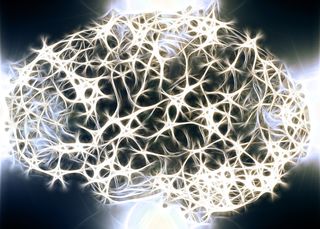Despite myriad self-help books promising easy and quick fixes, meaningful change takes persistence and hard work. As we saw in the previous post, we tend to fall back into existing patterns if we attempt to merely stop or reduce an unwanted behavior without replacing it with behaviors that take into account the role of that old habit.
Good intention is rarely enough. Given the bear-traps, not only do we need courage and determination to make changes that stick, we also need a very clever plan.
Here, a basic neuro-scientific understanding is invaluable. To break bad habits, you really have to work with your brain, not against it.

Habits (good and bad) get wired into our brains through a process called neuroplasticity. Whenever we think a particular thought or behave in a particular way, we activate the same groups of neurons. It is well-established that neurons that "fire together, wire together" (Hebb, 1949), so every time we repeat the same patterns of thought or behavior, we engrain them more strongly into our brains.
Habits of thought and behavior can be seen as well-worn ruts in our brains. Imagine a field that represents all of our possible thoughts… We could travel around and across it in many different routes. Now imagine scoring a few deep ruts across it—not only are we naturally drawn to familiar paths, but if we cross a rut despite having a different path in mind, we are likely to get stuck in it.
So the catch-22 is this: While we are wired for change (that is, new thoughts and behaviors will get stored in new connections and patterns in our brains), we are also built to resist change, in the sense that we will tend to get pulled back into existing patterns, which will then be unhelpfully strengthened. We like our worlds to be predictable, as it reduces psychological demands for decisions and new learning. Change goes against the grain...
All change depends on building new pathways in our brains, and/or weakening old ones. At the beginning, when we’ve successfully made positive changes such as resisting smoking for a few days, or going to the gym, say—for a period of time, the newly forming neuronal imprints of those new experiences are less strong and compelling that the original habitual ruts. Thus, to improve our chances of successful change, we must consciously counter the pull of the old, as well as make the desired changes.

Broadly speaking, to support change, we have to enhance our awareness of what we are doing and insert an extra ‘thinking’ stage in place of our automatic responses, until the desired changes have become strong enough to become the new default.
To do this, we need to identify our repertoire of habitual thought and behavior ‘ruts’ so we can be more conscious of when they have captured us. Every time we avoid or reduce time spent in our ruts, we are weakening them. In addition, when we reduce unhelpful rumination or behaviors, we generally feel better; and we free up resources for more constructive activities.
A greater awareness of the onset of unwanted patterns gives us a better chance of identifying the relevant triggers, too. Being aware of triggers helps alert us so we can avoid automatic "old" responses. However, successful change often depends on changing the environment itself by removing temptations or stressors that drive us to our bad behaviors, so that we require less psychological energy to maintain our intentions.
Sometimes we can reduce the pull of old thoughts by examining them directly. Remember Peter from the last post? On the surface, his goal was to do his back exercises… If, after some soul searching, he realizes that he has become lazy and fallen back into his role as the "sick one," and that he could already be more active even without "his back exercises," it’s now harder for him to tell himself that he "can’t."
A neuro-biological perspective also makes sense of the need to reduce stress to improve our chances of successful change. Put simply, when stressed, our tendency is to fall back into habits that require less psychological "energy" and resources. Furthermore, bad habits themselves are often our existing coping mechanisms for dealing with stress (e.g. smoking, avoidance); therefore, sustainable change often involves adding alternative stress-reduction behaviors (cf part 1).
Although often overlooked, sleep, diet, and exercise also make a direct impact on our capacity for change through their effects on basic stress systems. For this reason, lifestyle changes are often key to change, even if the specific desired change seems unconnected.

Of course, we need specific concrete goals directed at achieving our specific aims too. Much has been written about breaking goals into more manageable steps, but I do not want to add to that literature here (instead, see this and this).
Broadly speaking, we are best served by breaking change down into small specific steps—steps that are reasonable, measurable, and attainable in a specified length of time. For Peter, for example, his short-term goals might doing his back exercises just once a week, and attending an indoor (non-active) event with a bird-watching group, with the intention of joining them for walks at a specified point in the future.
The key is to start and experiment with what works for you, rather than getting hung up on the "perfect plan." An imperfect plan that is actually put into action is infinitely better than any plan that is not acted upon!
Though helpful, most of the commonly discussed guidelines for implementing change (e.g., SMART goals) have evolved from ideas to be used for change in the workplace and rarely take human psychology into account. However, if we remember that the best plans for meaningful change must take into account the role our habits have played (see part 1) and the need to actively manage our brain’s tendency to fall back on old habits until we’ve successfully "reprogrammed" it (as explained in this post), we will improve our chances of real change.
In the next (and final) part of this series, I look at how best to manage the inevitable hiccups on the way to change. Old ruts are almost unavoidable, despite our best efforts. However, it is what we do with our setbacks that determines whether we are ultimately successful in making the changes we want to see.
References
Hebb, D.O. (1949). The Organization of Behavior. New York: Wiley & Sons.




